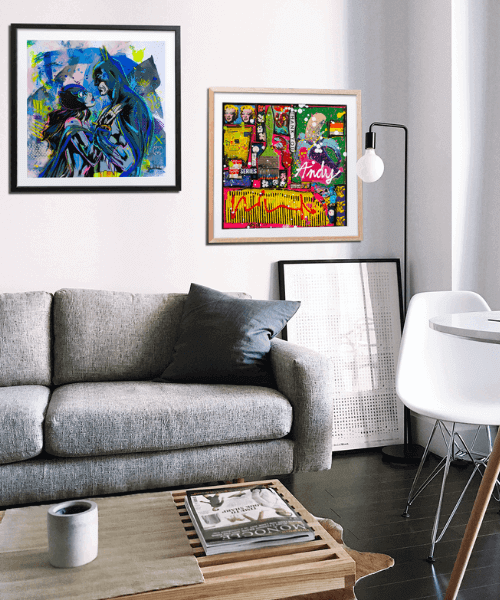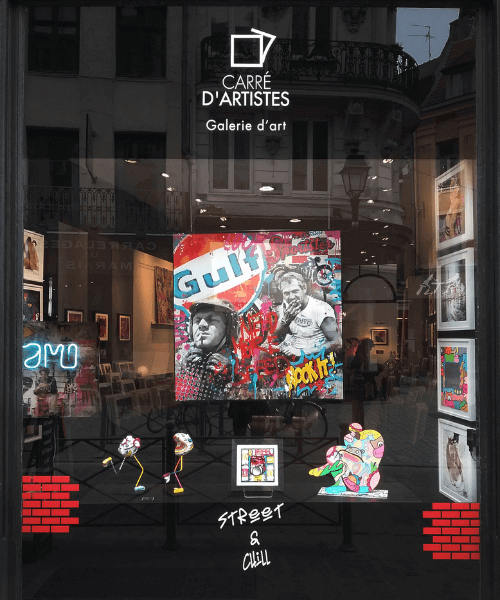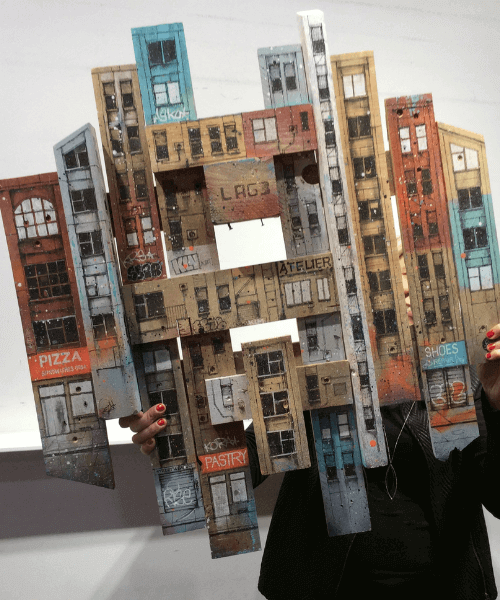How to choose a contemporary artwork?
How to select a contemporary artwork? There is no exact answer to this question.
The art collector is guided in his choice by his intuition and his tastes.
Art arouses emotions or inspires thought. It depends on how sensitive you are to a work of art.
How to choose a contemporary work of art? What are the trends in art and the artists of today?
Here are our tips for selecting a work that reflects your image.
Summary
- What is contemporary art?
- Why buy a contemporary artwork?
- What criteria should be taken into account when selecting a contemporary artwork?
- The history of contemporary art
- Currents of contemporary art
- The famous artists of today
- Where to buy a contemporary artwork?
- What is the difference between modern art and the art of our time?
What is contemporary art?
What is contemporary art? The most common definition of art in our time is that which refers to artistic works produced after the end of World War II.
Another definition is to say that a work of art of our time is characterized by artistic techniques that break free from the canonical codes of fine art, classical art and modern art.
By this definition, not all works of art produced today are part of current art.
In current art, the figurative functionality of art is abandoned in favor of an art that questions, questions and encourages reflection on our societies.
Contemporary art brings together works produced by artists (for the most part) still alive.
Why buy a contemporary artwork?
Contemporary art challenges and directly affects the public outside the institutional framework. It encourages reflection and contemplation.
By buying a work of our time, we share, in a way, the upheaval of the artist who expresses the imperfections of our society.
Buying a unique and original work represents support for emerging artists.
What criteria should be taken into account when selecting a contemporary artwork?
Contemporary art is spoiled for choice: painting, sculpture, drawing, collage, digital art, video, photo, work of art, abstract art, figurative art, land art, etc. Here are some tips to help you get started. select a work of art.


The type of artwork
The first point on which you will have to decide is that of the support: painting, sculpture, illustration, etc.
Dimensions are also important as they will need to be adapted to the space where you plan to place the artwork.
The theme of the artwork
The selection of the theme is very personal: still life, portrait, landscape, figurative or abstract work, etc.
You will need to consider spectators in a public place or follow your own tastes in the case of a work of art for your living room or any other room in the house.
The theme of the artwork
Another criterion that can help you prefer one work over another is to associate it with a time, place or emotion that you felt while contemplating the work.
The price of the work of art
The price of a work is a criterion to take into account.
However, the quality of the work cannot be judged on the sole criterion of price.
Even on a shoestring budget, you can acquire an expressive work created by one of the many artists of today.
The history of contemporary art
The history of contemporary art begins around 1950 when a group of artists in Europe attempted to overcome the traumas of war through art.
Post-war artists felt a need for renewal and a burning desire to define a new identity.
Europe is thus seeing the birth of several artistic currents which are inspired by movements already existing in the United States and Japan.
Current art represents a stylistic revival from modern art. It breaks with the representative functionality of reality and gradually becomes a form of expression that reflects the crises of society as perceived by artists.
Currents of contemporary art
The global climate of artistic effervescence saw the birth of several currents of contemporary art in the post-war period, the main ones being abstract expressionism or the New York School, pop art, conceptual art, and new realism. , Fluxus, land art, YBAs and street art.
Abstract Expressionism or New York School
Many artists fled Europe during World War II to settle in the United States and in particular in New York. Abstract Expressionism brings together a group of avant-garde immigrant artists (painters, poets, musicians, etc.) who revolutionized pictorial creation in the post-war era.
The painters of this artistic movement transcribe their feelings through large-format and colorful abstract canvases. Abstract expressionism brings together two currents:
- Action painting: gestural painting embodied by Jackson Pollock;
- The Colorfield: the painting with large areas of bright color represented by Mark Rothko
Pop art
Pop art is one of the most important movements in art today.It emerges from the 1960s in reaction to the society of mass consumption.
Its goal is to bring popular culture into the fine arts to make art accessible to everyone. Andy Warhol is the emblematic artist of this artistic movement.
Fluxus
This artistic movement born in the 1960s affects the visual arts as well as music and literature.
Like other trends, Fluxus questions the status of the artwork, the role of the artist, his place in society, etc.
Humor and derision are central to this form of antiart.
Conceptual art
This movement appeared in the 1960s.
Its origins, however, date back to the era of Marcel Duchamp's ready-made at the start of the 20th century.
This current considers that art is not defined by its aesthetic properties, but only by the concept or idea of art itself.
The new realism
This movement was founded in 1960 by the painter Yves Klein and the art critic Pierre Restany on the occasion of a group exhibition of French and Swiss artists at the Apollinaire gallery in Milan.
Contemporary of American pop art, it is often presented as the French version.
For the creation of their works, the artists recover everyday objects and transform them into powerful symbols of consumption.
Ce courant est fondé en 1960 par le peintre Yves Klein et le critique d’art Pierre Restany à l’occasion d’une exposition collective d’artistes français et suisses à la galerie Apollinaire de Milan.
Contemporain du pop art américain, il est souvent présenté comme la version française.
Pour la création de leurs œuvres, les artistes récupèrent des objets du quotidien et les transforment en symboles puissants de la consommation.
The Young British Artists (YBA) movement
A group of British artists have been organizing a series of exhibitions bearing this name from the 1990s.
Noted for their innovative techniques (materials and creative processes), they obtain wide media coverage.
Many artists rose to fame, including Damien Hirst, known for his cut-up animals. Public opinion is divided over certain artistic forms of the YBA
The famous artists of today
Some of the well-known contemporary artists include:
- Jeff Koons: kitsch style, neo-pop;
- Damien Hirst: conceptual artist and central figure of the YBA;
- David Hockney: painter, draftsman, engraver and decorator of the pop art style;
- Jenny Saville: painter member of the YBA, known for her gigantic nudes;
- Takashi Mukarami: visual artist and leader of the Japanese neo-pop movement;
- Anselm Kiefer: visual artist on the subject of the German post-war period;
- Jean-Michel Basquiat: avant-garde painter and pioneer of street art;
- Bansky: pseudonym of a street artist whose works often blend politics, humor and poetrer
- Christopher Wool: painter who makes gigantic stenciled letters on his paintings
Where to buy a contemporary artwork?
The usual places to buy a work of art are:
- the galleries ;
- fairs and exhibitions;
- on the Internet ;
- in art stores;
- directly from the artist.
What is the difference between modern art and the art of our time?
What is the difference between modern and contemporary art?
These are two distinct artistic movements that appeared between the end of the 19th century and the 1960s.
Temporal is the dominant criterion of distinction among art critics, museums and galleries.
It is questioned by some who consider that among all the works of art produced today, not all of them belong to the art of today.
Modern Art
Towards the end of the 19th century, painters set about deconstructing the reference system of the fine arts: imitation of the model, faithful representation of nature, idealized beauty, harmony of colors, etc.
They break with ancient art. The main artists of this movement are Courbet, Manet and Cézanne.
Painters transform the subjects of paintings and the ways of painting evolve.
Gradually other artists joined this movement (painters, sculptors, musicians, etc.). Until the 1960s, this was the period that saw the birth of art critics.
Contemporary art
The turning point in contemporary art is generally considered to be in the 1960s with the emergence of pop art.
This artistic current, totally breaking with academic canons, is inspired by the mass consumer society.
All the works produced from that time until today belong to contemporary art.
This definition raises questions, however, because not all works of art created today are considered to be pieces of contemporary art.
Complementary article
On the subject:
How to choose an artwork?
find out more :
- Choosing a modern artwork
- Price for an artwork
- Signature of an artwork
- Certificate of authenticity of an artwork
Other articles:
- What is contemporary art?
- History of contemporary art
- Currents of contemporary art
- Famous contemporary art
- Difference between modern art and contemporary art





